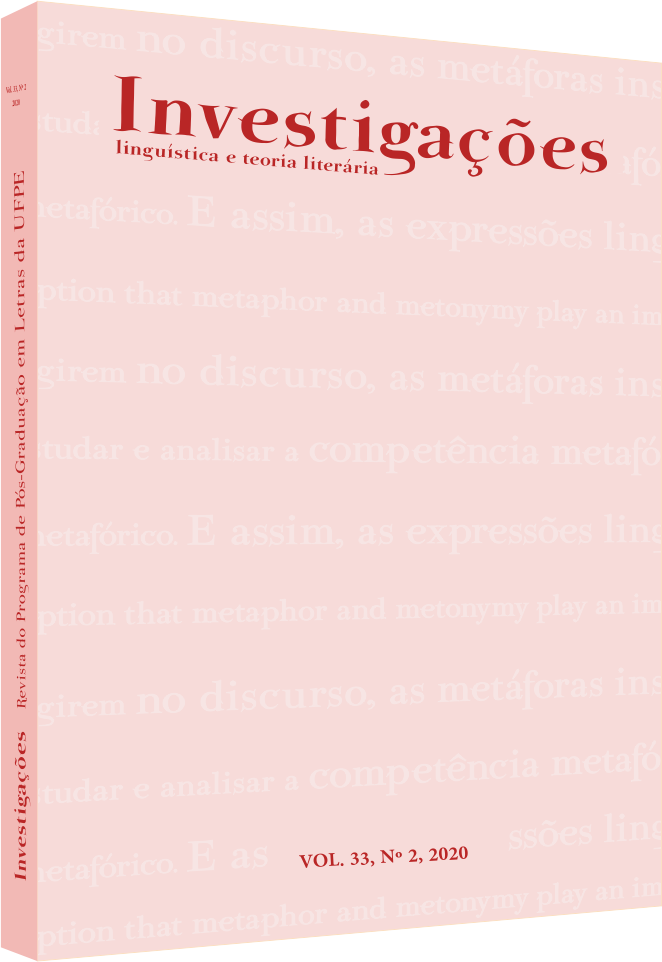Marcação Diferencial do Objeto direto (DOM) em kimwani, uma língua bantu
DOI:
https://doi.org/10.51359/2175-294x.2020.241749Keywords:
direct object marking, affectation, bantu language, Kimwani.Abstract
We describe and analyze the marking pattern of direct objects in Kimwani. We describe the Marking Type of the DOM and we present evidence that, in Kimwani the relevance hierarchy of the object does not relate the DOM to the scale or degree of affectation, but rather the [+ human] and [+ animality] traits are at the highest point of the hierarchy, and require differential marking in the direct object position. This result points in the opposite direction from Dowty (1991) theoretical proposal based on data from English, Hopper and Thompson (1980) and Nᴂss (2004) using data from several languages.References
AIKHENVALD, Alexandra Y. Verb types, non-canonically marked arguments and grammaticalrelations: ATariana perspective. 2001. In: ALEXANDRA Y. Aikhenvald R.M.W. Dixon & MASAYUKI Onishi. (edits). Non-Canonical Marking of Subjects and Objects. Pp. 177-200. John Benjamins Publishing Company. Vol. 45. Amsterdam/Philadelphia. 2001.
AIKHENVALD, A. Y. ‘‘Warekena’’. In: Handbook of Amazonian Languages, Vol. 4, D.C. Derbyshireand G. K. Pullum(eds). Berlin: Mouton de Gruyter. 1998a, Pp- 215–439.
ALEXANDRA Y. Aikhenvald R.M.W. Dixon & MASAYUKI Onishi. (edits). Non-canonical Marking of Subjects and Objects. John Benjamins PUBLISHING Company. Vol. 45. Amsterdam/Philadelphia. 2001.
BLEEK, Wiherm. A Comparative Grammar of South African Languages. London: Trübner. 1862.
COMRIE, Bernard. Aspect. Cambridge:Univesity Press.1976.
COMRIE, Bernard. Aspect. Cambridge: Cambridge University Press. 1998.
CHOMSKY, N. and HALLE, M. The sound pattern of English. New York: Harper and Row. 1968.
DIXON, R. M.W. Ergativity. Cambridge: Cambridge University Press. 1994.
AIKHENVALD, A. Y.. Grammatical relations in Tariana. Nordic Journal of Linguistics17: 201–18. 1994.
AIKHENVALD, A. Y.. The Semantic Basis of Sintactic properties. BLS 10, 583- 595.
DOWTY, David R. Thematic proto-roles and argument selection. Language:547-619. 1991.
GIVÓN, Talmy. Typology and functional domains. Studies in Languages 5.163-193. 1981.
GUTHRIE, Malcolm. Comparative Bantu: an introduction to the comparative linguistics and prehistory of the Bantu languages. 4 vols. Letchworth UK & 276 Brookfield VT: Gregg International.1967/71.
HOPPER, P.J. & THOMPSON, S. A. Transitivity in gramar and discourse. Language 56.251-299. 1980.
JAKOBSON, R. Zur Struktur des russichen Verbums. In Charisteria. G. Mathesio. Prague: Cercle Linguistique de Prague. 1932. Pp. 74-84.
LAZARD, G. Le marquage diférentiel de l´objet. 2001. In: Language typology and language universals: An international handbook, M. Haspelmath, E; König, W. Oesterreicher and W. Raible (edits.). Berlin: Mouton de Gruyter. 2001.
LEVIN, B. Objecthood: an event structure perspective. CLS 35, volume 1: The Main Session, 1999.
LEVIN, Beth and HOVAV, Malka Rappaport. Research Sueveys in Linguistics, Argument Realization. Cambridge University Press. 2005.
MARI, Broman Olsen and PHILIP, Resnik. Implicit Object Constructions and the (In)transitivity Continuum. In: 33rd Proceedings of the Chicago Linguistic Society, 1997.Pps 327–336.
MARTIN, Haspelmath. Non-canonical marking of core arguments in European languages. In: ALEXANDRA Y. Aikhenvald R.M.W. Dixon & MASAYUKI Onishi. (edits). Non-Canonical Marking of Subjects and Objects. Pp. 53-83. John Benjamins Publishing Company. Vol. 45. Amsterdam/Philadelphia. 2001.
MEINHOF, Carl. Introduction to the Phonology of the Bantu Languages. Berlim: Dretrich Reimer,1932.
NÆSS, Ǻshild. What markedness marks: the markedness problem with direct objects. Língua 114. 1186–1212. 2004. disponível online: www.sciencidirect.com
MOROLONG, MALILLO, & HYMAN, L. Animacy, objects, and clitics in Sesotho. Studies in African Linguistics 8; 199-217.1977.
NGONYANI, Deografia. Properties of Applied objects in Kiswahili and Kindendeule; Studies in African Linguistics, Volume 27, Number 1, spring 1998.
NGUNGA, Armindo. Introdução à Linguística Bantu. Imprensa Universitária. UEM. Maputo, 2004.
ONISHI, Masayuki. Introduction: Non-canonically marked subjects and objects:Parameters and Properties. In: ALEXANDRA Y. Aikhenvald R.M.W. Dixon & MASAYUKI Onishi. (edits). Non-Canonical Marking of Subjects and Objects. Pp. 1-52. John Benjamins Publishing Company. Vol. 45. Amsterdam/Philadelphia. 2001.
“Autor”, . Tom gramatical em kimwani. Dissertação de Mestrado. Universidade Pedagógica de Moçambique. 2016.
SITOI, Bento e Ngunga, Armindo (Org). II Seminário sobre a Padronização da Ortografia de Línguas Moçambicanas, NELIMO, UEM. 2000.
TRUBETZKOY, N. S. Grundzuge der Phonologie. Travaux du Cercle Linguistique de Prague 7. 1939.
Downloads
Published
How to Cite
Issue
Section
License
Copyright (c) 2020 Calawia Salimo, Marco Antonio Rocha Martins

This work is licensed under a Creative Commons Attribution 4.0 International License.
Authors who publish with Revista Investigações agree to the following terms:
Authors retain copyright and grant the journal right of first publication with the work simultaneously licensed under the Creative Commons Attribution 4.0 International (CC BY 4.0) license that allows others to share the work with an acknowledgement of the work's authorship and initial publication in this journal.
Authors are able to enter into separate, additional contractual arrangements for the non-exclusive distribution of the journal's published version of the work (e.g., post it to an institutional repository or publish it in a book), with an acknowledgement of its initial publication in this journal.
You are free to:
Share — copy and redistribute the material in any medium or format for any purpose, even commercially.
Adapt — remix, transform, and build upon the material for any purpose, even commercially.
The licensor cannot revoke these freedoms as long as you follow the license terms.
Under the following terms:
Attribution — You must give appropriate credit , provide a link to the license, and indicate if changes were made . You may do so in any reasonable manner, but not in any way that suggests the licensor endorses you or your use.
No additional restrictions — You may not apply legal terms or technological measures that legally restrict others from doing anything the license permits.

